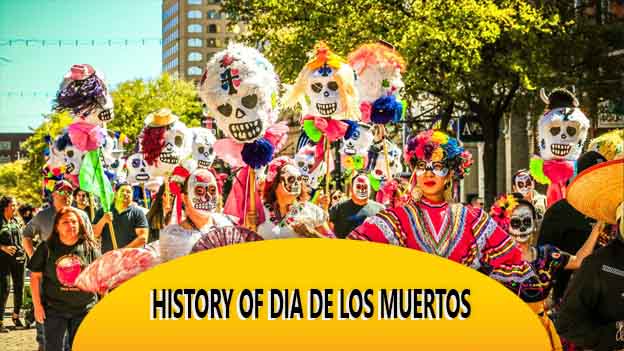History Of Dia De Los Muertos: Dia de los Muertos, also known as the Day of the Dead, is a vibrant and deeply rooted Mexican tradition that honors and celebrates the memories of departed loved ones. This unique holiday is a blend of indigenous rituals and Catholicism and takes place on November 1st and 2nd each year. Dia de los Muertos is not a somber occasion but rather a joyous commemoration filled with colorful decorations, delicious food, and lively festivities.
- Pre-Hispanic Origins
- Influence of Catholicism
- Altars and Offerings
- Calacas and Calaveras
- La Catrina
- Day of the Dead Celebrations
- Dias de los Muertos Around the World
- Misconceptions and Hollywood Influence
- Dia de los Muertos in the 21st Century
- Cultural Significance and Resilience
- Conclusion
- FAQs: History Of Dia De Los Muertos
Pre-Hispanic Origins
The origins of Dia de los Muertos can be traced back to the indigenous peoples of Mexico, such as the Aztecs, Maya, Purepecha, and Nahua. These ancient civilizations believed that death was just a continuation of life, and the deceased would embark on a spiritual journey to the afterlife. Various rituals were performed to honor the dead, and offerings were made to guide their souls on their path. History Of Dia De Los Muertos.
Influence of Catholicism
With the arrival of Spanish conquistadors in the 16th century, Catholicism was introduced to Mexico, blending with existing indigenous traditions. The celebration of Dia de los Muertos became intertwined with the Catholic holidays of All Saints’ Day and All Souls’ Day, which are observed on November 1st and 2nd respectively.
Altars and Offerings
One of the central elements of Dia de los Muertos is the creation of altars, known as “ofrendas,” in homes and cemeteries. These altars are adorned with marigold flowers, candles, incense, and the favorite foods and beverages of the departed. Families also place photographs and personal belongings of their deceased loved ones on the altar as a way to welcome their spirits back to the world of the living.
Calacas and Calaveras
Calacas, or decorative skeletons, and calaveras, which are sugar skulls, are iconic symbols of Dia de los Muertos. These cheerful and colorful representations of death are used in various forms of artwork, costumes, and decorations during the celebrations. They serve as a reminder that death is an integral part of life and that it should be embraced with a positive outlook.
- Also Read:
La Catrina
La Catrina is perhaps the most famous symbol associated with Dia de los Muertos. Created by the Mexican artist Jose Guadalupe Posada, La Catrina is a skeletal figure of an elegantly dressed woman. This iconic image has become synonymous with the holiday and serves as a reminder of the universality of death, as even the rich and beautiful must face mortality.
Day of the Dead Celebrations
In Mexico, Dia de los Muertos is a public holiday, and communities come together to celebrate with parades, music, dancing, and lively processions. Many cities also host grand festivals featuring art exhibitions, traditional dances, and performances to commemorate the occasion.
Dias de los Muertos Around the World
While Dia de los Muertos is deeply rooted in Mexican culture, its popularity has spread beyond Mexico’s borders. In recent years, people from various countries have embraced the celebration, appreciating its unique blend of honoring the dead while celebrating life.
Misconceptions and Hollywood Influence
Dia de los Muertos is often confused with Halloween, particularly due to the proximity of dates. However, the two holidays have distinct origins and customs. Furthermore, Hollywood’s portrayal of Dia de los Muertos has sometimes perpetuated inaccuracies, blending it with Halloween themes and commercializing the holiday.
Dia de los Muertos in the 21st Century
As with many traditions, Dia de los Muertos has evolved over time. In the modern era, technology and globalization have influenced how people celebrate the holiday. Social media platforms and online memorials now provide additional ways for individuals to honor their departed loved ones.
Cultural Significance and Resilience
Dia de los Muertos not only celebrates the memory of loved ones but also reflects the resilience and cultural pride of the Mexican people. Despite historical challenges and attempts to suppress indigenous traditions, this vibrant holiday has persisted and continues to be an integral part of Mexican identity.
Conclusion
History Of Dia De Los Muertos: Dia de los Muertos is a culturally rich and meaningful celebration that highlights the beauty of remembering those who have passed on. Through its unique blend of indigenous customs and Catholic influences, this holiday stands as a testament to the enduring spirit of the Mexican people. As the world becomes more interconnected, Dia de los Muertos serves as a powerful reminder of the importance of honoring our roots and embracing the cycle of life and death.
FAQs: History Of Dia De Los Muertos
-
Is Dia de los Muertos only celebrated in Mexico?
Dia de los Muertos is primarily celebrated in Mexico, but its popularity has extended to various countries, particularly in areas with significant Mexican communities.
-
Is Dia de los Muertos a sad occasion?
No, Dia de los Muertos is a joyful celebration of life and a way to remember and honor the deceased with love and happiness.
-
Are the calacas and calaveras meant to be scary?
No, they are not meant to be scary. Instead, they represent the joyous and festive nature of the holiday, embracing death as a natural part of life.
-
What are some traditional foods served during Dia de los Muertos?
Traditional foods include pan de muerto (bread of the dead), sugar skulls, tamales, and various fruits and candies.
-
Can non-Mexicans participate in Dia de los Muertos celebrations?
Yes, Dia de los Muertos is a celebration that welcomes people from all backgrounds to join in remembering and honoring the deceased.
